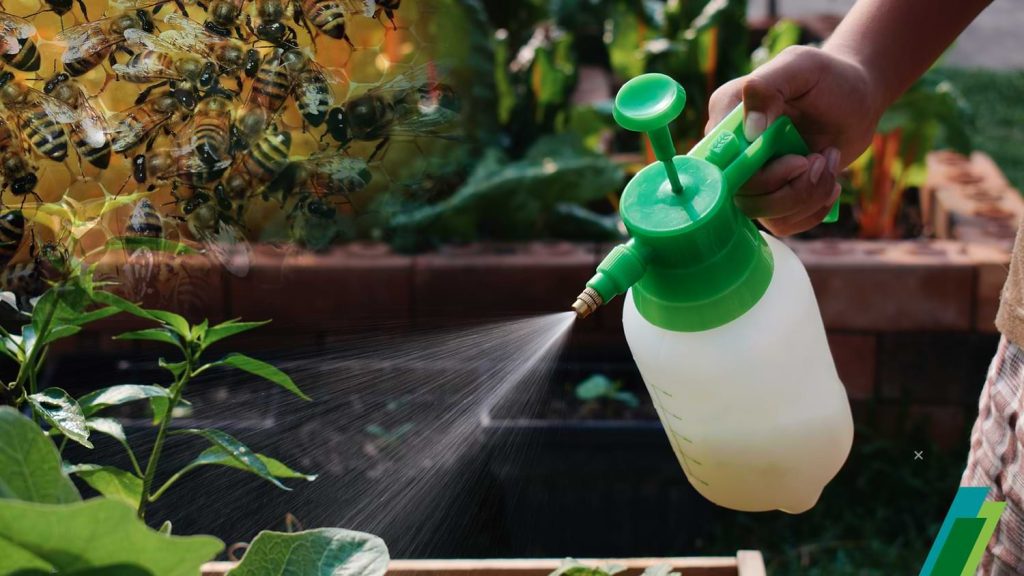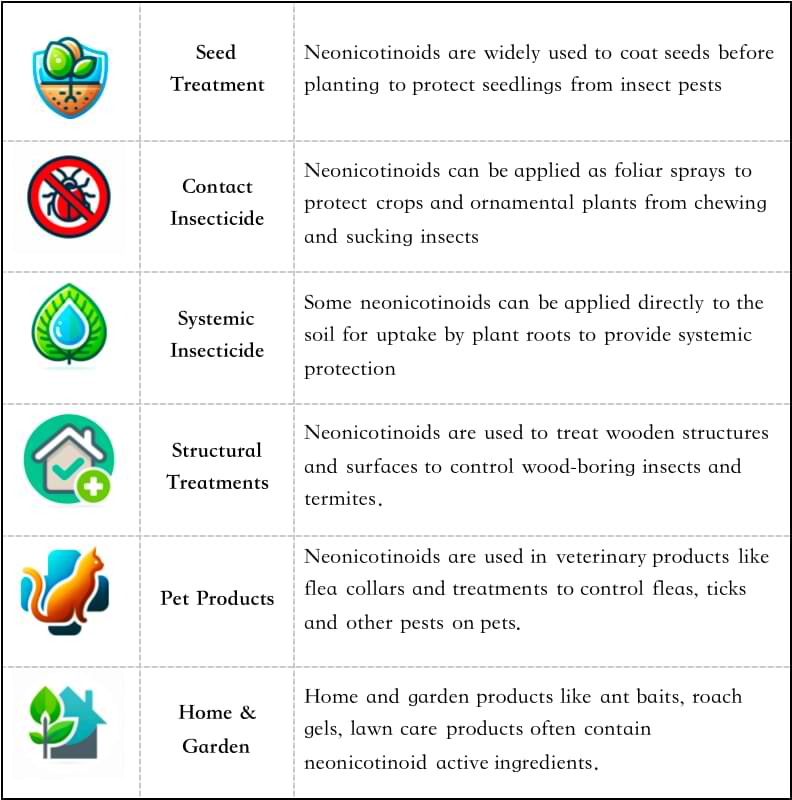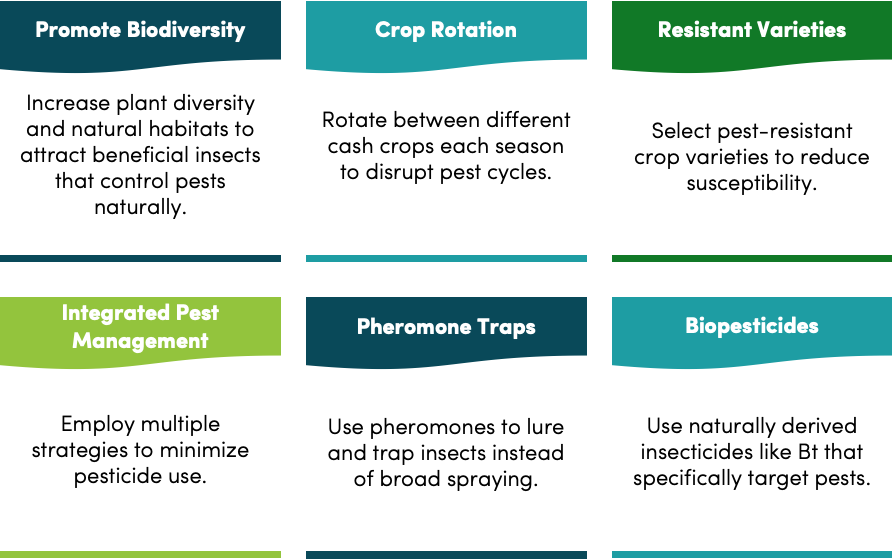
In agriculture, neonicotinoid insecticides have emerged as a pivotal force in the battle against crop-devouring pests, promising bountiful yields and enhanced food security. Yet, the narrative surrounding these chemicals is not one of triumph alone. As we delve into the world of neonicotinoids, we uncover a complex saga marked by controversy and unintended consequences. This article will navigate the dualistic nature of neonicotinoids, examining their role as both protectors of our crops and potential threats to our environment. From the molecular workings that disrupt pests to the global movements aiming to curb their use, we will explore the intricate tapestry of agricultural advances, ecological impacts, and the quest for sustainable solutions. What is the future of this chemical compound that is expected to reach nearly USD $10 billion in value by the year 2025?
NEONICOTINOID IS A DOUBLE-EDGED SWORD
Neonicotinoids are chemically related to nicotine, a neurotoxicants that target the central nervous system by binding to nicotinic acetylcholine receptors leading to overstimulation, in other words communication within the insect brain areas are disturbed, and this leads to paralysis and death.
Seven separate neonicotinoid compounds are available commercially worldwide: imidacloprid, thiacloprid, clothianidin, thiamethoxam, acetamiprid, nitenpyram and dinotefuran, with some newer compounds such as sulfoxaflor. Since the introduction of imidacloprid in 1994, neonicotinoid insecticides have been a worldwide commercial success. Neonicotinoids are used in four major domains: (i) plant protection of crops and ornamentals against herbivorous insects and mites, (ii) urban pest control targeting organisms such as cockroaches, ants, termites, flies, etc., and (iii) veterinary applications (against fleas, ticks, etc. on pets and domestic livestock). The main use seems to be for plant protection, including protection of trees in agriculture, horticulture, tree nursery, and forestry.
On neonicotinoids being a double-edged sword – “while these properties ensure greater and longer duration of exposure to potential insect pests, non-target insects are similarly exposed to greater and longer exposure to toxic insecticide”.
Neonicotinoids are active against a broad spectrum of economically important crop pests that include borers, leaf-eater caterpillars, leafhoppers, planthoppers and others. Neonicotinoids are systemic insecticides; meaning that regardless of the manner of application and route of entry to the plant, they do not remain on the plant’s surface but enter the vascular system and are translocated throughout all plant tissues, making them toxic to any insects (and potentially other organisms) that feed upon the plant. Some neonicotinoids are very persistent, and they can remain for several years and accumulate in the surrounding environment, especially soil, due to repeated use.
Additionally, neonicotinoids can be easily dissolved in water and slowly break down in soil, traits that have led to their popularity. However, it is a double-edged sword; while these properties ensure greater and longer duration of exposure to potential insect pests, non-target insects are similarly exposed to greater and longer exposure to the toxic insecticide hence affecting even the aquatic systems which are a source of food for many.

THE NEGATIVE EFFECTS OF NEONICOTINOIDS
About a decade ago, adverse effects of neonicotinoids towards non-target insects, especially pollinators, were seriously brought into question. The topic arose particularly because of the great losses suffered by the bee population, a vital pollinator, all over the world; a phenomenon called bee colony collapse disorder, for which neonicotinoids were named as a major factor. Bees and other pollinator insects are immensely important for humans and for crop yield. Bees are potentially exposed to pesticides through their role of pollinating crops. Research studies reported that while trace levels of neonicotinoids used in agriculture usually do not kill the bees directly, their indirect (sublethal) influence showed all the symptoms of insecticide poisoning. Among the symptoms of bees exposed to sublethal levels of neonicotinoids in laboratory and field studies are uncoordinated movements, tremors, and convulsions. This affects the capacity of bees to forage, learn, remember flower locations, and find the route back to the colony, hive, or swarm. Additionally, it can negatively influence the growth of honeybee and bumblebee colonies and the fertility of queens. While these do not lead to sudden death of the insects, bees die sooner and more frequently due to worsening of their health, disruption of nutrition processes, and impaired sense of smell and navigational abilities. Though neonicotinoids are often named the culprit for the bee colony collapse disorder, it should be noted that other insecticide group such as pyrethroids (which have been widely detected in pollen), fipronil, and organophosphates have also been reported as factors for the decline of insect pollinator species.
On the damages caused – other than being responsible for the bee colony collapse disorder, effects are also seen on birds that feed on insects and seeds that has been exposed to neonicotinoids, and reduction in lizard species.
Though neonicotinoids are highly toxic to insects, recent studies are showing that their effects are not solely confined to insects. Insectivorous birds (birds that primarily feed on insects), who could secondarily consume neonicotinoids by consuming insects that are exposed to neonicotinoids, and exclusively granivorous bird (birds that consume seeds) species that eat neonicotinoid coated seeds, are at high risk for secondary and primary poisoning respectively. Recent reports of decline in insectivorous birds from the Netherlands and France postulate that this observation seems to be associated with the use of neonicotinoid insecticides in the field or in seed-coating.
A review on the direct and indirect impact of insecticides on the ecosystem link impaired growth in fish and reduction in lizard species due to the use of neonicotinoids on their insect prey. Surface waters in agricultural areas have also been shown to contain neonicotinoid concentrations that exceed acute and chronic “invertebrate aquatic life benchmarks” and toxicity thresholds. Birds could also be exposed to neonicotinoids through direct contact with skin and feathers. Neonicotinoids have been reported in European honey buzzards, barn owls and several hummingbird species; these non-granivorous and predatory birds may be exposed to neonicotinoids through the consumption of contaminated nectar or wild bees, rat preys exposed to neonicotinoids or through feather contact. To date, mammals seem to be exempt from adverse effects of neonicotinoids usage, probably due to the differential binding abilities of neonicotinoids to invertebrate and vertebrate cholinergic receptors, which indicates that neonicotinoids generally pose lower acute hazards to mammals.
In Malaysia for example, imidacloprid is a broad-spectrum neonicotinoid insecticide that is used to control rice-planthoppers, leaf-planthoppers and other pests, has been shown to be present in the blood serum of paddy farmers. This can lead to serious health problems which will be borne by the country’s healthcare system.
In response to the adverse effects of neonicotinoids towards non-target insects, measures have been taken by the European Union in the form of a moratorium on the use of three molecules (imidacloprid, clothianidin and thiamethoxam) on selected crops that came into force in 2013. The Commission Implementing Regulation (EU) No. 485/2013 of 24 May 2013 amended Implementing Regulation (EU) No. 540/ 2011, concerning the approval conditions of active substances clothianidin, thiamethoxam, and imidacloprid, and prohibited the use and sale of seeds treated with plant protection products containing those active substance. Since January 2019, a new regulation stated a ban of these three molecules in all outdoor crops, restricting them to greenhouses. Additionally, many countries in Europe like Germany and France have introduced their own prohibitions on the use of neonicotinoids.
On restrictions of use – A new regulation in EU to ban the use of three (neonicotinoid) molecules in all outdoor crops came into effect in January 2019.
TOWARDS SUSTAINABLE SOLUTIONS
An alternative to the use of chemical pesticides, such as neonicotinoids, is to substitute harmful synthetic pesticides with biopesticides or pest-resistant crops. Pest-resistant crops are genetically improved plant varieties produced by classical plant breeding or genetic modification techniques. However, this approach seems to have mixed reactions. For example, though the use of genetically modified plant varieties engineered to be toxic to pests report initial pesticide decrease, insects have reportedly developed resistance to these toxins. Biological control, which is the control of a pest by the introduction of a natural enemy or predator, is another alternative to the use of neonicotinoids and other chemical insecticides. The most promising substitutable methods involve the use of microorganisms such as granulosis bacteria and fungus, such as Bacillus thuringiensis and Metarhizium anisopliae. Physical methods, for example the coating of fruit with paraffin oil or clay, and semiochemical methods, which is the disruption of insect mating with sex pheromones, have also proven quite effective and are often available as commercial products. Though it should be noted that the effectiveness of these non-chemical alternatives to neonicotinoids depends on the target pest.

A more expansive approach that can reduce or even eliminate the use of synthetic pesticides is integrated pest management (IPM). IPM focuses on managing pests using a combination of biological, cultural and chemical practices with the aim to minimize ecological disruption, rather than focusing on the sole elimination of pests. IPM programs work to monitor for pests and identify them accurately, so that appropriate control methods can be carried out. Prevention is a first line of pest control in IPM programs, which involves the management of the habitat or environment to prevent pests from becoming a threat. In the context of an agricultural crop, this may include cultural methods such as rotating between different crops, selecting pest-resistant varieties, and planting pest-free rootstock. When preventive methods are no longer effective, then proper pest control methods are deployed. This threshold can be indicated from regular monitoring and identification. Effective and lower risk control methods are carried out first, this includes the use of highly targeted chemicals, such as pheromones to disrupt pest mating, or mechanical control, such as trapping. If further monitoring indicates that these methods are not effective, then additional pest control methods are employed, such as targeted spraying of pesticides at insect pest hotspots. Biological control methods can also be employed once the insect species are identified. Predatory or parasitic insects and mites known as ‘beneficials’ or ‘good bugs’ can help to control chewing and sucking insects by killing them or disrupting their breeding cycle. Additionally, beneficial plants can be planted to attract beneficial insects.
The use of RNA as a sustainable insecticide represents a groundbreaking approach in the field of pest management, offering a highly specific and environmentally friendly alternative to traditional chemical pesticides. This innovative strategy involves the use of RNA interference (RNAi) technology, where double-stranded RNA (dsRNA) is designed to target and silence specific genes within pest organisms, effectively disrupting vital biological processes and leading to their mortality. Unlike broad-spectrum chemical insecticides, RNA-based insecticides can be tailored to target only the intended pest species, minimizing harm to beneficial insects, such as pollinators, and reducing the ecological footprint. This specificity also reduces the risk of non-target organisms developing resistance, a common problem with conventional pesticides. Furthermore, because RNA degrades naturally in the environment, this approach significantly lowers the risk of environmental contamination associated with traditional pest control methods. As such, RNA-based insecticides hold great promise for sustainable agriculture, offering a novel solution to pest management that aligns with the principles of environmental conservation and ecosystem health.
There are also several promising insect control methods that are still at the research and development phase stage and yet to be practiced. Among these are plant defense elicitors (elicitors are low molecular weight compounds that trigger the plants’ defense responses), multiple plant-based semiochemicals, gene editing for the development of resistant crop varieties, and conservation biological control methods (which aims to integrate beneficial insects back into crop areas for natural pest control). However, these methods still require further development, more testing in field conditions and improvements to meet farmers’ needs before release onto the market. Additionally, there is a glaring lack of the adverse pesticide effects towards non-target species in Malaysia and Southeast Asia. To date, most studies of non-target poisoning are from North America and Europe, with some reports from Australia and New Zealand. More research is needed to identify and control the risk of non-target poisoning in tropical countries, like Malaysia, where there is higher species diversity, including more pollinator and insect species, which could at risk to non-target effects from neonicotinoid use.
On alternative strategies – “alternative strategies such as integrated pest management and innovative RNA-based insecticides are illuminating the path toward sustainable agriculture”.
As we stand at the crossroads of agricultural necessity and ecological sensitivity, the story of neonicotinoid insecticides imparts a multifaceted lesson. These chemicals, once hailed as a panacea for pest problems, now bear the burden of proof in demonstrating their safety to the ecosystems they coexist with. The decline in pollinator populations and the ripple effects on non-target species have ignited a global conversation on the ethics of chemical use in our fields. In the pursuit of balance, alternative strategies such as integrated pest management and innovative RNA-based insecticides are illuminating the path toward sustainable agriculture. While the curtain has yet to close on the neonicotinoid narrative, the movement towards methods that honor our environmental responsibilities continues to gain momentum. The challenge lies not only in feeding our growing population but in nourishing the health of our planet with every seed we sow.




